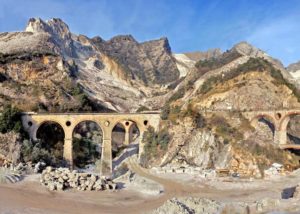
Along with ancient villages, cities of art, paradise islands and seaside resorts, our coast has another glory to show to the rest of the world: the Carrara Marble quarries.
The dusty roads leading to the Carrara marble quarries slip into a serpentine path along the Apuane slopes, offering unique views and strong emotions. You proceed by driving slowly and cautious, crossing dark and improvised tunnels excavated in marble and semi-perpetual trails overlooking the crevices. A true “on the road” experience, full of suspense and adventure, where we recommend the utmost caution.
Several Marble Caves can also be visited inside, such as the quarry located in the square of the Fantiscritti in Miseglia (Carrara). For issues of extreme security, it is strictly forbidden to visit the marble quarries autonomously. To get in, we rely on organizations that make guided tours in total security.
The Fantiscritti quarry is still active: pickings are made in the morning, while in the afternoon guests are welcomed. If you are looking to visit the quarry, there is nothing left to greet the daylight and get, on board of a minivan, into the belly of the mountain. The insiDE of the quarry is breathtaking: highest walls, marble ceilings and marble floors to be admired step after step. In this lunar environment, the sounds echo in a deafening silence: the smallest drop of water resounds loud and majestic at its first contact with the ground.
It is no coincidence that the Carrara Marble Caves are chosen as exclusive locations by famous musicians and singers, attracted by the extraordinary acoustics of the caves. Among the many guests, David Bryan, keyboardist of Bon Jovi, in 2012 charmed his fans by playing a spectacular marble piano inside the quarry.
Guided tours will also allow you to know the history and the secrets of marble processing, material extracted from the times of the ancient Roman Empire (II century BC). Even today, an element valued in every corner of the planet used to build villas, floors, finish interiors or raise monuments.
And if, like us, you love “on the road” experiences, dedicate the hours after your visit to wander with your car along the Apuane, perhaps stopping at one of the most striking stop-points: The Vara Bridges(Ponti di Vara). A magnificent architectural work of the late eighteenth century, part of a former marble railway where steam trains continued to travel until recent past.
 Italiano
Italiano



